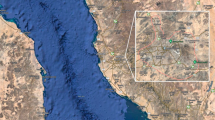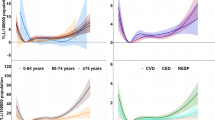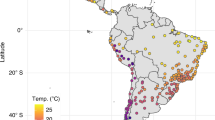Abstract
To assess YLL and mortality burden attributable to non-optimum ambient temperature, we collected mortality and environmental data from June 1, 2012 to December 30, 2017 in Shenzhen. We applied distributed lag nonlinear models with 21 days of lag to examine temperature–YLL and temperature–mortality associations, and calculated the attributable fractions of YLL and deaths for non-optimum temperature, including four subranges, mild cold, mild heat, extreme cold, and extreme heat. Cold and heat were distinguished by the optimum temperature, and each was separated into extreme and mild by cutoffs at 2.5th (12.2 °C) and 97.5th (30.4 °C) temperature percentile further. The optimum temperature was defined as the temperature that had minimum effect on YLL or mortality risk. The optimum temperature for non-accidental YLL was 24.5 °C, and for mortality it was 25.4 °C. Except for the population older than 65 years, the optimum temperature was generally lower in the YLL model than the mortality model. Of the total 61,576 non-accidental deaths and 1,350,835.7 YLL within the study period, 17.28% (95% empirical CI 9.42–25.14%) of YLL and 17.27% (12.70–21.34%) of mortality were attributable to non-optimum temperature. More YLL was caused by cold (10.14%, 3.94–16.36%) than by heat (7.14%, 0.47–13.88%). Mild cold (12.2–24.5 °C) was responsible for far more YLL (8.78%, 3.00–14.61%) than extreme cold (3.5–12.2 °C). As for cardiovascular deaths, only the fractions attributable to overall and cold temperature were significant, with mild cold contributing the largest fraction to YLL (16.31%, 6.85–25.82%) and mortality (16.08%, 9.77–21.22%). Most of the temperature-related YLL and mortality was attributable to mild but non-optimum weather, especially mild cold, while the YLL model implied a more prominent heat effect on premature death. Our findings can supply additional evidence from multiperspectives for health planners to define priorities and make targeted policies for mitigating the burden of adverse temperatures.
This is a preview of subscription content, access via your institution
Access options
Subscribe to this journal
Receive 6 print issues and online access
$259.00 per year
only $43.17 per issue
Buy this article
- Purchase on Springer Link
- Instant access to full article PDF
Prices may be subject to local taxes which are calculated during checkout




Similar content being viewed by others
References
Ye XF, Wolff R, Yu WW, Vaneckova P, Pan XC, Tong SL. Ambient temperature and morbidity: a review of epidemiological evidence. Environ Health Perspect. 2012;120:19–28.
Bunker A, Wildenhain J, Vandenbergh A, Henschke N, Rocklov J, Hajat S, et al. Effects of air temperature on climate-sensitive mortality and morbidity outcomes in the elderly: a systematic review and meta-analysis of epidemiological evidence. Ebiomedicine. 2016;6:258–68.
Kovats RS, Hajat S. Heat stress and public health: a critical review. Annu Rev Publ Health. 2008;29:41.
Yang ZM, Wang Q, Liu PF. Extreme temperature and mortality: evidence from China. Int J Biometeorol. 2019;63:29–50.
Hajat S, Kosatky T. Heat-related mortality: a review and exploration of heterogeneity. J Epidemiol Commun H. 2010;64:753–60.
Song XP, Wang SG, Hu YL, Yue M, Zhang TT, Liu Y, et al. Impact of ambient temperature on morbidity and mortality: an overview of reviews. Sci Total Environ. 2017;586:241–54.
Huang CR, Barnett AG, Wang XM, Tong SL. The impact of temperature on years of life lost in Brisbane, Australia. Nat Clim Change. 2012;2:265–70.
Yang J, Ou CQ, Song YF, Li L, Chen PY, Liu QY. Estimating years of life lost from cardiovascular mortality related to air pollution in Guangzhou, China. Sci Total Environ. 2016;573:1566–72.
Steenland K, Armstrong B. An overview of methods for calculating the burden of disease due to specific risk factors. Epidemiology. 2006;17:512–9.
Chen RJ, Yin P, Wang LJ, Liu C, Niu Y, Wang WD, et al. Association between ambient temperature and mortality risk and burden: time series study in 272 main Chinese cities. Br Med J. 2018;363:k4306.
Gasparrini A, Guo YM, Hashizume M, Lavigne E, Zanobetti A, Schwartz J, et al. Mortality risk attributable to high and low ambient temperature: a multicountry observational study. Lancet. 2015;386:369–75.
Zhang YQ, Peng MJ, Wang L, Yu CH. Association of diurnal temperature range with daily mortality in England and Wales: a nationwide time-series study. Sci Total Environ. 2018;619:291–300.
Gasparrini A, Armstrong B, Kenward MG. Distributed lag non-linear models. Stat Med. 2010;29:2224–34.
Guo YM, Li SS, Tian ZX, Pan XC, Zhang JL, Williams G. The burden of air pollution on years of life lost in Beijing, China, 2004-08: retrospective regression analysis of daily deaths. Br Med J. 2013;347:f7139.
Yang J, Ou CQ, Guo YM, Li L, Guo C, Chen PY, et al. The burden of ambient temperature on years of life lost in Guangzhou, China. Sci Rep. 2015;5:12250.
Gasparrini A, Leone M. Attributable risk from distributed lag models. BMC Med Res Methodol. 2014;14:55.
Ma WJ, Chen RJ, Kan HD. Temperature-related mortality in 17 large Chinese cities: how heat and cold affect mortality in China. Environ Res. 2014;134:127–33.
Wu W, Xiao YZ, Li GC, Zeng WL, Lin HL, Rutherford S, et al. Temperature-mortality relationship in four subtropical Chinese cities: a time-series study using a distributed lag non-linear model. Sci Total Environ. 2013;449:355–62.
Vicedo-Cabrera AM, Sera F, Guo Y, Chung Y, Arbuthnott K, Tong S, et al. A multi-country analysis on potential adaptive mechanisms to cold and heat in a changing climate. Environ Int. 2018;111:239–46.
Li GX, Huang J, Xu GZ, Pan XC, Qian XJ, Xu JY, et al. Temporal variation in associations between temperature and years of life lost in a southern China city with typical subtropical climate. Sci Rep. 2017;7:4650.
Yang J, Ou CQ, Ding Y, Zhou YX, Chen PY. Daily temperature and mortality: a study of distributed lag non-linear effect and effect modification in Guangzhou. Environ Health. 2012;11:63.
Zhang YQ, Yu CH, Peng MJ, Zhang L. The burden of ambient temperature on years of life lost: a multi-community analysis in Hubei, China. Sci Total Environ. 2018;621:1491–8.
Zhang J, Li TT, Tan JG, Huang CR, Kan HD. Impact of temperature on mortality in three major Chinese cities. Biomed Environ Sci. 2014;27:485–94.
Kouis P, Kakkoura M, Ziogas K, Paschalidou AK, Papatheodorou SI. The effect of ambient air temperature on cardiovascular and respiratory mortality in Thessaloniki, Greece. Sci Total Environ. 2019;647:1351–8.
Yang J, Yin P, Zhou MG, Ou CQ, Guo YM, Gasparrini A, et al. Cardiovascular mortality risk attributable to ambient temperature in China. Heart. 2015;101:1966–72.
Yang J, Yin P, Zhou MG, Ou CQ, Li MM, Li J, et al. The burden of stroke mortality attributable to cold and hot ambient temperatures: epidemiological evidence from China. Environ Int. 2016;92–93:232–8.
Lee W, Choi HM, Kim D, Honda Y, Guo YLL, Kim H. Temporal changes in mortality attributed to heat extremes for 57 cities in Northeast Asia. Sci Total Environ. 2018;616:703–9.
Guo YM, Barnett AG, Zhang YS, Tong SL, Yu WW, Pan XC. The short-term effect of air pollution on cardiovascular mortality in Tianjin, China: comparison of time series and case-crossover analyses. Sci Total Environ. 2010;409:300–6.
Zhu JY, Zhang XH, Zhang X, Dong M, Wu JM, Dong YQ, et al. The burden of ambient air pollution on years of life lost in Wuxi, China, 2012-2015: a time-series study using a distributed lag non-linear model. Environ Pollut. 2017;224:689–97.
Gardner JW, Sanborn JS. Years of potential life lost (YPLL)-what does it measure? Epidemiol. 1990;1:322–9.
Analitis A, Katsouyanni K, Biggeri A, Baccini M, Forsberg B, Bisanti L, et al. Effects of cold weather on mortality: results from 15 European cities within the PHEWE project. Am J Epidemiol. 2008;168:1397–408.
Baccini M, Biggeri A, Accetta G, Kosatsky T, Katsouyanni K, Analitis A, et al. Heat effects on mortality in 15 European cities. Epidemiol. 2008;19:711–9.
Zhou MG, Wang HD, Zhu J, Chen WQ, Wang LH, Liu SW, et al. Cause-specific mortality for 240 causes in China during 1990-2013: a systematic subnational analysis for the Global Burden of Disease Study 2013. Lancet. 2016;387:251–72.
Yang J, Zhou MG, Ou CQ, Yin P, Li MM, Tong SL, et al. Seasonal variations of temperature-related mortality burden from cardiovascular disease and myocardial infarction in China. Environ Pollut. 2017;224:400–6.
Yu WW, Vaneckova P, Mengersen K, Pan XC, Tong SL. Is the association between temperature and mortality modified by age, gender and socio-economic status? Sci Total Environ. 2010;408:3513–8.
Zanobetti A, O’Neill MS, Gronlund CJ, Schwartz JD. Susceptibility to mortality in weather extremes effect modification by personal and small-area characteristics. Epidemiol. 2013;24:809–19.
Le Y, Ren J, Shen J, Li T, Zhang CF. The changing gender differences in life expectancy in Chinese cities 2005-2010. PLoS ONE 2015;10:e0123320.
Medalia C, Chang VW. Gender equality, development, and cross-national sex gaps in life expectancy. Int J Comp Sociol. 2011;52:371–89.
Seifarth JE, McGowan CL, Milne KJ. Sex and life expectancy. Gend Med. 2012;9:390–401.
Li YH, Cheng YB, Cui GQ, Peng CQ, Xu Y, Wang YL, et al. Association between high temperature and mortality in metropolitan areas of four cities in various climatic zones in China: a time-series study. Environ Health. 2014;13:65.
Burse RL. Sex differences in human thermoregulatory response to heat and cold stress. Hum Factors. 1979;21:687–99.
Medina-Ramon M, Schwartz J. Temperature, temperature extremes, and mortality: a study of acclimatisation and effect modification in 50 US cities. Occup Environ Med. 2007;64:827–33.
Bhaskaran K, Gasparrini A, Hajat S, Smeeth L, Armstrong B. Time series regression studies in environmental epidemiology. Int J Epidemiol. 2013;42:1187–95.
Acknowledgements
We thank all staff from the Center for Disease Control and Prevention of Shenzhen who have made a great contribution to the data collection, supplements, auditing, and database management. This study was supported by the National Natural Science Foundation of China (No. 81573262). The funder of the study had no role in study design, data collection, data analysis, data interpretation, or writing of the report. The corresponding author had full access to all data in the study, and had the final responsibility for the decision to submit for publication.
Author information
Authors and Affiliations
Corresponding authors
Ethics declarations
Conflict of interest
The authors declare that they have no conflict of interest.
Additional information
Publisher’s note Springer Nature remains neutral with regard to jurisdictional claims in published maps and institutional affiliations.
Supplementary information
Rights and permissions
About this article
Cite this article
Li, H., Yao, Y., Duan, Y. et al. Years of life lost and mortality risk attributable to non-optimum temperature in Shenzhen: a time-series study. J Expo Sci Environ Epidemiol 31, 187–196 (2021). https://doi.org/10.1038/s41370-020-0202-x
Received:
Revised:
Accepted:
Published:
Issue Date:
DOI: https://doi.org/10.1038/s41370-020-0202-x
Keywords
This article is cited by
-
Association between ambient temperature and childhood respiratory hospital visits in Beijing, China: a time-series study (2013–2017)
Environmental Science and Pollution Research (2021)



